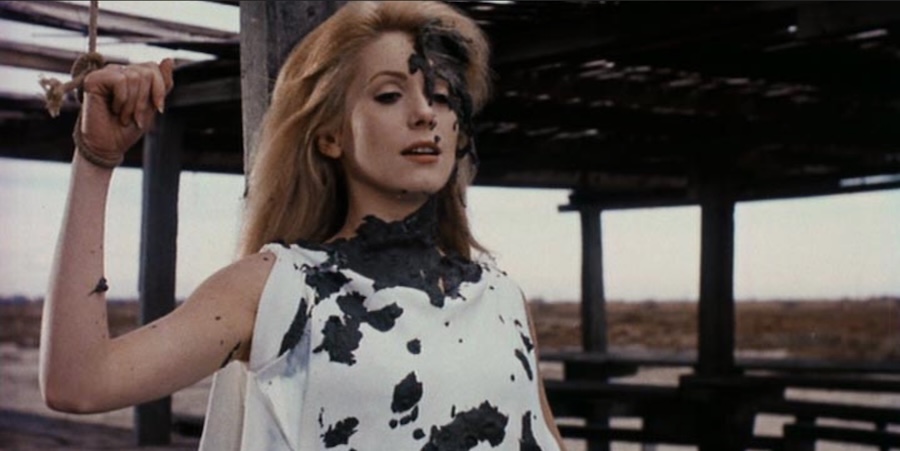
LUIS BUÑUEL’S MASTERPIECE OF EROTICA!

Luis Buñuel scholar Julie Jones once claimed that the famous director told her that he doesn’t know what the end of this film really means. That’s reassuring because neither do I. All I know is that it reconnects with the opening, even if there is one major difference. It’s up to you to figure out what these scenes say about the central relationship and fantasies of Catherine Deneuve’s character. This film, often labeled an erotic masterpiece, is a fascinating look at the power of sexual desires and daydreaming.
Tied to a tree
The film opens with a horse-and-buggy-ride with affluent Parisians Pierre and Séverine Serizy (Jean Sorel, Deneuve) as passengers. They have a fight and Pierre stops the ride and orders the coachmen to grab his wife and tie her to a tree. She is thoroughly whipped and then raped by one of the coachmen. It turns out to be a dream and Séverine finds herself back in her Paris apartment along with her kind, meek husband. She often has these violent, absurd sexual fantasies, but won’t tell Pierre. Everyone in her life has the idea that she’s a somewhat prudish woman. She runs into one of Pierre’s friends, the rather vulgar Henri Husson (Michel Piccoli), who mentions a specific brothel in the city that he occasionally frequents.
She works up the courage to go there and is instantly hired as one of Madame Anaïs’s (Geneviève Page) girls. The first encounter with a client makes her run back to her husband… but she soon comes back and turns into one of Madame’s favorite girls.
Dreams and fantasies about the forbidden
One of the director’s best known and most highly praised films, Belle de Jour is reminiscent of several other previous Buñuel films, not least Viridiana (1961) where Francisco Rabal also played a major part. There’s the depiction of the bourgeoisie; they live in elegant apartments and live charmed lives, but scratch the surface and nothing turns out to be what it seems. Buñuel and Bergman must have had a lot to talk about.
There’s also the bizarre and absurd, the legacy of the director’s cut-up eye in Un Chien Andalou (1929), revealed in dreams and fantasies about the forbidden. There’s even a scene that looks like it was borrowed from an old, French gangster movie. After a few initial mistakes, Séverine learns how to become the perfect whore and even participates in a necrophiliac game in a stately, old mansion – her humiliation continues after that when she is literally thrown out into the rain. Her new secret life is an embarrassment to some degree, but there is no way that she could live without it. Things turn dramatic when Séverine has sex with a young gangster (Pierre Clementi) who becomes smitten with her and threatens to tell her husband. She tries to pretend like it’s no big deal… but erasing perversion would be like killing a key part of herself.
Catherine Deneuve delivers an excellent performance; her beauty is traditional and conservative… but we also notice the fire burning inside her.
Deneuve delivers an excellent performance; her beauty is traditional and conservative… but we also notice the fire burning inside her. Piccoli and Page are also memorable as the friend who frequently tries people’s limits and the madam who keeps a strict but loving eye on her girls.
We’re never quite sure of when Séverine is daydreaming, which leaves a lot of room for various interpretations. The fantasies are a secret escape, and perhaps that is all she’s doing; she may never actually turn to prostitution. In any case, her longing for an open, uninhibited life is bound to speak to many in the audience. Not that they would admit to it.
Belle de Jour 1967-France-Italy. 100 min. Color. Directed by Luis Buñuel. Screenplay: Luis Buñuel, Jean-Claude Carrière. Novel: Joseph Kessel. Cinematography: Sacha Vierny. Cast: Catherine Deneuve (Séverine Serizy), Jean Sorel (Pierre Serizy), Michel Piccoli (Henri Husson), Geneviève Page, Francisco Rabal, Pierre Clementi.
Trivia: Followed by Belle Toujours (2006).
Venice: Golden Lion.
Last word: “Some people said [Buñuel] was not that deaf, but I think, when you don’t hear very well and when you’re tired, everything sinks into a buzz, and it is very hard. French is not his language, so on Belle de Jour, I’m sure that it was much more of an effort for him to have to explain. I’ve always thought that he likes actors, up to a point. I think he likes very much the idea of the film, and to write it. But I had the impression that the film-making was not what he preferred to do. He had to go through actors, and he liked them if they were easy, simple, not too much fuss. He would say very little to actors. But then, there weren’t many ways to do the scenes. You couldn’t really fool around with the script – it was very precise.” (Deneuve, The Guardian)
